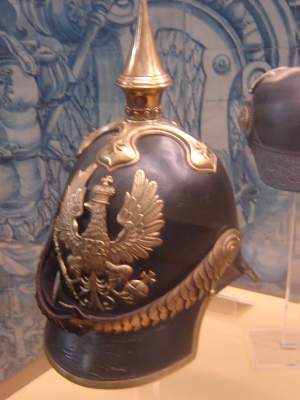| |
Prussian
Pickelhaube M1842
The Prussian infantry adopted a
new single breasted dark blue
uniform and spiked leather
helmet (Pickelhaube) on
23 October 1842. The original
Prussian design had a spike with
a cruciform base, chin scales, a
metal edged squared peak all in
yellow metal. On the front was a
crowned yellow metal Prussian
Eagle. Variations on the eagle
were worn by different units. Under the left side chin
scale boss was the Prussian
(black/white/black) cockade.
The
Prussian Cuirassier heavy
cavalry, meanwhile adopted a
similar spiked helmet in
polished steel with a lobster
tail neck guard.
On
parade duty the spike could be
replaced by a horse hair plume
for some units. This was usually
white or black, depending on the
unit and red for musicians.
Generals wore feathered plumes.
The development of the Prussian
Pickelhaube is excellently
covered on the
Kaiser's Bunker Website.
Soon
after, several other German
states adopted similar helmets
(often made in Prussia), but
each with their own variations
of heraldic front plates,
cockades, spikes and other
details. The articles on this
website will deal with the
differences worn by the smaller
states as seen on surviving
examples.
Much
of the information on these
pages is from:
'Kopfbedeckungen.
Band 5, Teil I: Die Verbreitung
der Pickelhaube in den deutschen
Staaten' published by
the Military History Museum,
Rastatt |
|

Prussian Line Infantry
Officers
Pickelhaube M1842
Portuguese Military Museum,
Lisbon |
|